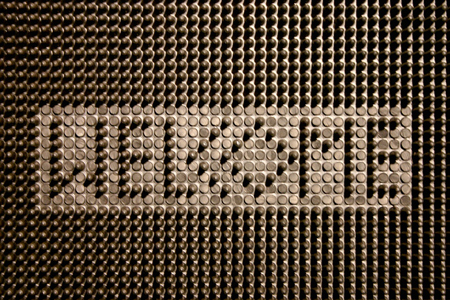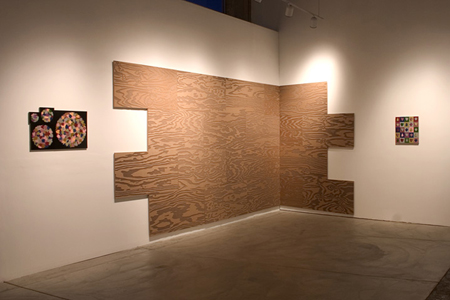ANDREW SUTHERLAND
PEOPLEText: Garry Waller
Which came first…the painting or the plastic?
Painting came long before plastic.
How did the idea to use plastic come about?
Several years ago I started mass-producing a series of small sculptural plaques based on three cartoon-like shapes taken out of my sketchbook. Originally I was cutting each one out of wood, and hand machining it into the final piece. This process was too time and labor intensive, so I turned to plastic as a way of speeding up that process. In essence the idea to use plastic came out of necessity.

Andrew Sutherland, Welcome (detail), 2005, Modified rubber mat, 23″ x 15″
Can you explain a bit about the process of making your plastic work and what it involves?
I don’t have formal training with mold making and casting, but I think my process is similar to the traditional approach. I start by creating an original, then make a mold from that. Once I have the mold, I use a two part liquid plastic to make the castings. For color, I have a technique that involves pouring the paint. This gives it a very smooth, seemless finish, as if from the factory. If you look at the back of the pieces it’s apparent from the fingerprints and drips that they’re actually handmade. In theory it seems like a simple process, but there are actually a lot of unseen steps, and takes a long time. Because of this I haven’t been producing then as much, and am thinking about having them outsourced.

Installation View, 2004, carved corrugated cardboard panels, 20′ x 8′, Sixspace, Los Angeles, CA
Is the process part of the appeal or is it more about the end result for you?
I love the process. The process is also where a lot of my ideas are conceived. I, however, am a very visual person, and therefore also place a large emphasis on the final product. I guess it’s something like a relationship were one can’t live without the other. I’m not so much the type that can dream up something out of thin air, but I admire that type of artist. I would be interested in a balance, having some things fabricated for me, but also continuing with the hands-on work that is natural to me.
How do you see your work evolving and what’s next for you?
I have a tendency to over-edit my ideas. I’ll find great things in my studio that I’ve made, but that I never fully developed. I want to share more of these ideas with people. I feel that my future exhibitions will be more eclectic, showing a wider range of ideas and work. I’ve had several exhibitions in the US, and I feel that my next step to get my work out there on an international level. I’m currently researching places to show in Japan and Europe. Also, I’ve been thinking a lot about making a book.
What inspires you?
Music I listen to in the studio: Metallica, Slayer, G’n’R, Papoose, Nirvana, Dip Set, Mozart, Hank Williams, ZZ Top, Townes Van Zandt, William Basinski.
What artists’ have influenced you?
Contemporary artists that have influenced me: Tim Hawkinson, Tom Friedman, Barry McGee, Clare Rojas, Kenzo Minami, My Brother Peter, Kaws, Ryan Mcginnis, Roxy Paine, Tara Donovan.
See Andrew at work in his short film “Formation”, a behind the scenes look into some of the methods and techniques that go into his work.
Text: Garry Waller
Photos: Courtesy of Andrew Sutherland





